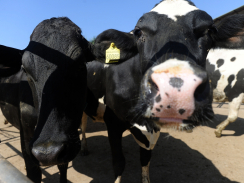When President Obama explained his plan to save the planetary climate in a speech delivered at Georgetown University on Tuesday, he did not mention cattle, but he did state his desire “to make sure that we’re not seeing methane emissions.”
Videos By Rare
Some of those, the government has made clear, are of bovine origin.
Back in 2007, the Environmental Protection Agency published a paper explaining its effort to develop a model “to estimate methane from enteric fermentation in cattle.”
“During digestion, microbes resident in an animal’s digestive system ferment food consumed by the animal,” the paper explained. “This microbial fermentation process, referred to as enteric fermentation, produces methane as a byproduct, which can be exhaled or eructated by the animal.”
So? Have not animals been eructating methane for millennia?
“Cattle are the largest contributing livestock species to enteric fermentation in the United States, accounting for over 95 percent of the methane emissions from this source,” said the EPA paper. “These emissions account for almost 20 percent of the total anthropogenic-methane emissions in the United States.”
So?
Well, climate-change cognoscenti can find an answer in the Climate Action Plan the White House released Tuesday in conjunction with the president’s speech.
“Curbing emissions of methane is critical to our overall effort to address global climate change,” says the president’s plan. “Methane currently accounts for roughly 9 percent of domestic greenhouse gas emissions and has a global warming potential that is more than 20 times greater than carbon dioxide.”
In this view of things, the dairy cow that produced the milk you fed to your child, and the steer that yielded the steak you hope to throw on the grill next Saturday, are threatening the planet.
“Cattle Eructation Leads to Global Devastation” may be too simplistic a bumper sticker for their cause — but they are unmistakably saying cattle eructations are at least one cause leading toward global devastation via manmade (or is it man- and bovine-made?) global warming.
That is why, even back in 2007, when George W. Bush was president, the EPA’s cattle-eructation experts were developing a plan for monitoring methane emissions.
“In order to more accurately characterize emissions from this source, EPA has recently focused its attention on adopting and improving the Intergovernmental Panel on Climate Change (IPCC) Tier 2 method for estimating methane emission from cattle,” said the EPA paper.
Indeed, EPA planned to track — at least through estimates — what American cattle were doing on a month-by-month basis.
“The most significant modification to the IPCC Tier 2 method that EPA made was to model cattle sub-populations on a monthly basis,” said the paper. “Factors such as weight gain, birth rates, pregnancy, feedlot placements and slaughter rates were tracked to characterize the U.S. cattle population in greater detail than in previous inventories, in which only end-of-year population data were used.”
Is a federal government that seeks to measure and modulate the methane emissions of cattle overreaching?
John Holdren, who as director of the White House Office of Science and Technology Policy is President Obama’s top science adviser, joined in 1995 with Paul Ehrlich and Gretchen Daily of the Center for Conservation Biology at Stanford to co-author a chapter in a book on “sustainability” published by the World Bank.
In this chapter, Holdren, Ehrlich and Daily argue that the human race was approaching the point at which there should be no more growth.
“Many of the practices inadequately supporting today’s population of 5.5 billion people are unsustainable; and at the sustainability limit, there will be a trade-off between population and energy-matter throughput per person, hence, ultimately, between economic activity per person and well-being per person,” Holdren and his co-authors wrote.
“This is enough,” they said, “to say quite a lot about what needs to be faced up to eventually (a world of zero net physical growth), what should be done now (change unsustainable practices, reduce excessive material consumption, slow down population growth) and what the penalty will be for postponing attention to population limitation (lower well-being per person).”
In 1973, Holdren co-authored a book with Paul Ehrlich and Anne Ehrlich titled, “Human Ecology.” In the conclusion of this book, Obama’s future science adviser said: “A massive campaign must be launched to restore a high-quality environment in North America and to de-develop the United States. De-development means bringing our economic system (especially patterns of consumption) into line with the realities of ecology and the global resource situation. Resources and energy must be diverted from frivolous and wasteful uses in overdeveloped countries to filling the genuine needs of underdeveloped countries”
“Redistribution of wealth both within and among nations,” wrote Obama’s future science adviser, along with Paul and Anne Ehrlich, “is absolutely essential, if a decent life is to be provided to every human being.”
Terence P. Jeffrey is the editor-in-chief of CNSnews.com.
© CREATORS.COM

